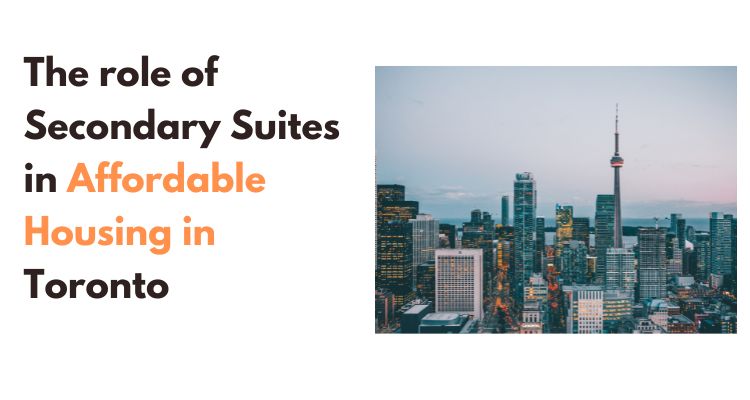Introduction
Housing, one of the basic human needs, has become a tough nut to crack in Toronto. Affordable housing in Toronto seems to be more of a myth than a reality for many residents. The cost of living keeps spiraling upwards, and with it, the price of houses.
The city’s vibrant culture and opportunities draw in people, but the steep real estate prices often turn dreams of settling down here into an uphill battle. So, what’s the solution? Secondary suites – a potential game-changer in Toronto’s affordable housing scene.
Often referred to as “Income Suite” or “basement apartments,” secondary suites are self-contained residential units located within a primary dwelling. These suites have their separated kitchen, bathroom, and living area. Given their inherent low cost of production and ability to integrate into existing neighborhoods, secondary suites offer a promising solution to addressing housing affordability in Toronto. In this article, we will explore the roles they play in ensuring affordable housing in Toronto.
What are Secondary Suites?
Let’s get to know secondary suites a bit better. At their core, secondary suites are independent residential spaces inside a primary property. They’re like a mini-house within a house, equipped with all the essentials – a kitchen, dining, living, bedroom, bathroom, and closets. But here’s the fun part – they come in various shapes and sizes:
- Basement Apartments: As the name suggests, these suites are tucked away in the basement of a house. They’re a popular option due to their private entryways and ample living space.
- Laneway Houses: These small, stand-alone homes are usually built in the backyards of residential lots and face onto a public lane. They’re particularly favored in Toronto for their ability to blend into existing neighborhoods.
- Garden Suites: These are detached structures located in the rear yard of a residential property. They got their name because, yes, you guessed it, they often overlook a garden. They’re similar to laneway houses but don’t necessarily face a public lane.
- Coach Houses: These secondary suites are built above a detached garage. They make fantastic use of space that might otherwise go unused.
Keep in mind; that the kind of secondary suite that works best depends greatly on the layout and size of the primary property.
Importance of secondary suites as affordable housing options
Secondary suites are pivotal in addressing the affordable housing crisis in Toronto. As the city grapples with housing affordability issues, secondary suites offer a viable and practical solution. By converting underutilized spaces within existing properties into self-contained units, secondary suites not only increase the housing supply but also do so without altering the character of established neighborhoods.
For homeowners, these suites offer an opportunity to generate additional income by renting out the space, thereby offsetting mortgage costs. For renters, on the other hand, secondary suites provide an affordable alternative to the costly single-family homes and condominiums in the city. Given the rising real estate prices and limited availability of affordable homes in Toronto, secondary suites have come to represent distinctive, flexible, and cost-effective housing options.
Moreover, by allowing for more efficient use of the existing housing stock and infrastructure, secondary suites also align with city-wide goals of housing targets, sustainable growth and urban density. They offer a unique solution to the city’s housing needs, blending affordability with accessibility, and enhancing the diversity of housing options available in the city.
Benefits of Secondary Suites in Affordable Housing
Increased Housing Supply and Density
Secondary suites contribute significantly to increasing the housing supply and density in Toronto. By transforming unused spaces within existing homes into standalone units, the availability of residential spaces is enhanced without the need for new constructions or major modifications. This surge in housing supply helps in meeting the ever-growing demand for affordable houses in Toronto, thereby easing the housing crunch.
Accessible and Affordable Housing Options for Individuals and Families in Toronto
Secondary suites stand out as a tangible solution to the affordability crisis in the housing market, especially in bustling cities like Toronto. These suites are often more economical than traditional standalone housing units, making them a practical choice for individuals and families seeking accessible and affordable housing options.
Rental income potential for homeowners
Homeowners in Toronto can significantly benefit from the incorporation of secondary suites in their properties. By renting out these self-contained units, homeowners can generate a steady stream of supplementary income. This rental revenue can be used to offset mortgage payments or other expenses, thus providing financial relief.
Potential to Increase Property Value and Increase the Tax Base
Secondary suites not only enhance the functionality of a property but also increase its market value. By adding a fully equipped, independent living space, homeowners can augment the value of their property. This in turn contributes to an expanded tax base for the city. Moreover, by enhancing the range of affordable housing options in Toronto, secondary suites play a pivotal role in fostering a diverse and inclusive community.
Key Considerations for Secondary Suites in Affordable Housing
Zoning regulations and bylaws
Before embarking on creating a secondary suite, homeowners must familiarize themselves with the Toronto Official Zoning bylaws. These rules dictate what type of secondary suites are permissible in certain areas and stipulate specific requirements regarding size, height, and more. It is crucial to consult with your local government or a planning professional to ensure your project aligns with these regulations.
Safety and building code standards
Safety is paramount when it comes to designing and building secondary suites. Homeowners must adhere to building code standards, which cover aspects such as fire separations, means of egress, minimum ceiling heights, and more. Non-compliance not only jeopardizes occupants’ safety but may also result in penalties.
Potential impact on neighborhood aesthetics and parking
Secondary suites, particularly detached ones like above-garage suites and garden suites, can impact neighborhood aesthetics and parking availability. It’s important to consider how your suite will fit in with the neighborhood’s character and whether adequate parking can be provided. Consulting with neighbors and community associations can help address potential concerns.
Tenant-landlord relationships and responsibilities
When renting out a secondary suite, homeowners become landlords with specific legal responsibilities. This includes maintaining the property, respecting the tenant’s rights, and adhering to rules regarding rent increases, evictions, and more. It’s important to understand these responsibilities to prevent legal disputes.
Government Policies and Initiatives for Affordable Housing in Toronto
- Supportive policies to encourage secondary suite development
The Toronto government has implemented a range of supportive policies aimed at encouraging the development of secondary suites. One such initiative is the introduction of flexible zoning bylaws, which have been amended to permit as much as 4 secondary suites as-of-right in all residential areas across the city. These measures showcase the city’s commitment to fostering affordable housing, making it easier for homeowners to tap into the benefits of secondary suites.
- Financial incentives and grants
The Toronto government also offers financial incentives and grants to homeowners to encourage the development of secondary suites. These fiscal aids can offset the initial costs of constructing these units, making it a more feasible option for homeowners. Such incentives underscore the city’s proactive approach to addressing the affordable housing crisis.
- Streamlining the application and approval processes for secondary suites
To foster convenience and efficiency, the Toronto government has streamlined the application and approval processes for secondary suites. Homeowners wanting to construct secondary suites can now avail of expedited permit processing times, simplified application procedures, and reduced fees. This initiative aims to remove bureaucratic hurdles and promote a hassle-free experience for homeowners, further motivating them to contribute to the city’s affordable housing stock.
Community Engagement and Collaboration for Secondary Suites
The importance of collaboration between homeowners, tenants, and local community organizations
Effective implementation and acceptance of secondary suites in the community hinge on the active collaboration between homeowners, tenants, and local community organizations. By fostering open dialogue and cooperation, potential issues such as neighborhood aesthetics and parking can be tactfully addressed. Equally important is the role of community organizations in educating homeowners about their responsibilities and rights as landlords, as well as providing support to tenants in understanding their rights. This collaborative approach creates a harmonious living environment, promoting the successful integration of secondary suites into the community fabric.
Promoting public awareness and education about secondary suites
Homeowners, potential tenants, and the general public should be well-informed about the benefits, regulations, and responsibilities associated with secondary suites. This can be achieved via informational sessions, community workshops, or online resources. With an informed community, potential misconceptions can be dispelled, fostering a positive outlook towards secondary suites. Moreover, education empowers homeowners and tenants, enabling them to make informed decisions and engage in fair dealings. Ultimately, public awareness and education are pivotal in promoting the sustainable growth of secondary suites as a viable solution to the affordable housing crisis.
Conclusion
Secondary suites are a promising avenue to address Toronto’s housing affordability crisis. From flexible zoning bylaws to financial incentives and streamlined processes, the city is making significant strides in promoting these beneficial units.
As we navigate our way through the intricate landscape of urban living, it becomes clear that innovative solutions like secondary suites are essential for the development of inclusive, thriving communities. The shared responsibility between the government, homeowners, tenants, and community members cannot be overstated. By understanding and embracing our roles, we can collectively contribute to the growth of affordable housing and ensure a brighter, more sustainable future for all. Policymakers and residents alike are urged to continue advocating for secondary suites, and homeowners are encouraged to explore the potential within their properties for such developments. As we move forward, let’s remain informed, proactive, and committed to fostering a more affordable Toronto.
FAQs
- What safety and building code standards do secondary suites need to adhere to?
Secondary suites must comply with local building and fire codes which include, but are not limited to, requirements for ceiling height, window size, and proper exit routes. It’s advisable to consult with a professional contractor or local building department to ensure compliance.
- How do secondary suites help increase housing supply and density in Toronto?
Secondary suites effectively make use of existing residential space to provide additional housing units. This not only increases the supply of affordable housing but also contributes to increasing neighborhood density, which can support local businesses and make public transit more viable.
- How can individuals and policymakers support and advocate for the expansion of secondary suites as a solution to the housing affordability crisis in Toronto?
Individuals can support the expansion of secondary suites by becoming informed about its benefits and advocating for it in their communities. Policymakers can assist by creating and enforcing regulations that encourage the creation of secondary suites, providing financial incentives to homeowners, and raising awareness about the benefits of secondary suites.
- What resources or financial incentives are available to homeowners who want to create secondary suites in Toronto?
The Toronto government provides various financial incentives and resources to encourage homeowners to develop secondary suites. This includes the Home Energy Loan Program (HELP), which offers low-interest loans to homeowners who are improving energy efficiency, and the Toronto Renovates program, which provides funding for homeowners to improve their homes. There’s also a guidebook available to homeowners to understand the process of creating a secondary suite and the regulatory requirements that come with it.


